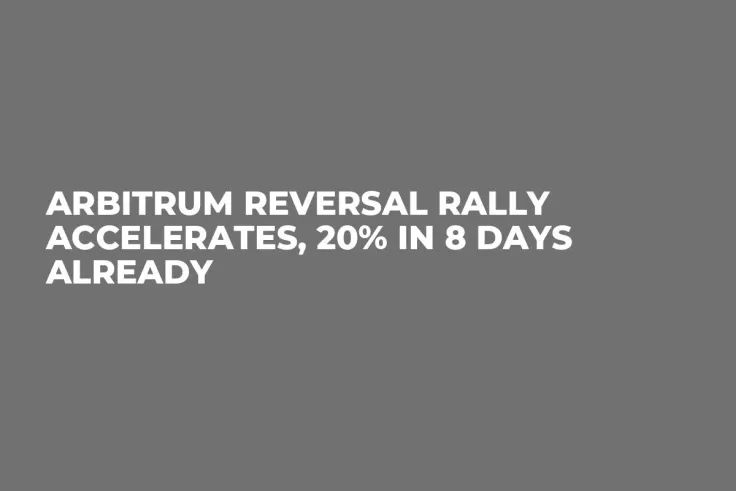
Disclaimer: The opinions expressed by our writers are their own and do not represent the views of U.Today. The financial and market information provided on U.Today is intended for informational purposes only. U.Today is not liable for any financial losses incurred while trading cryptocurrencies. Conduct your own research by contacting financial experts before making any investment decisions. We believe that all content is accurate as of the date of publication, but certain offers mentioned may no longer be available.
Arbitrum, the Layer 2 scaling solution for Ethereum, has experienced a noteworthy rally in the last eight days, with its value surging by more than 20%. This surge has been primarily driven by the challenging circumstances that Ethereum, the Layer 1 network, has recently faced. Ethereum users have been contending with significant finality issues and exorbitant fees for basic network interactions.
From May 11 to 12, Ethereum experienced two instances where over 60% of its validators stopped performing their duties. This led to a loss in finality, which is the state in which a supermajority of validators have confirmed the final state of the blockchain, ensuring that a block and its transactions cannot be altered or removed.
This interruption did not affect end users on the Ethereum mainnet, but it did trigger the first-ever inactivity leak, an emergency state where inactive validators are increasingly penalized until they are diluted out of the chain or begin participating again. The penalties applied during the inactivity leak are effectively burned, resulting in lower ETH issuance during that time.
In contrast, Arbitrum's recent trajectory shows the promise of decentralized networks overcoming governance hurdles. A little over a month ago, the Arbitrum Foundation moved 750 million ARB tokens, worth about $1 billion, to its own wallets without community approval. This move was voted against by the community, leading to the proposal of new actions to make the governance of the DAO more accessible.
Sui aims for recovery?
Despite recent turbulence in the cryptocurrency market, the price of Sui (SUI), a relatively new entry, has shown remarkable resilience. It has managed to recover swiftly, raising questions among investors whether the $2 mark could be its next target.
The recent performance of SUI can be attributed to the gradual redistribution of the token among a broad base of investors. This has resulted in the token facing less intense selling pressure, giving it a more stable base for price growth. If the trend continues, the ambitious target set by bulls might not be far from reality, especially with the overall market sentiment remaining positive.
Sui's price recovery aligns with the growing demand for new, innovative digital assets that offer something beyond the standard features of more established cryptocurrencies. With a well-defined and transparent tokenomic structure, SUI has attracted investors looking for promising projects that provide both utility and potential for significant return on investment.
However, it is crucial to remember that the journey to the $2 mark will not be without its challenges. Market volatility, regulatory developments and changes in investor sentiment can all impact SUI's price trajectory. Moreover, as SUI is still a relatively new asset, it is susceptible to large price swings that might deter some potential investors.
Lido launches fundamental update
Lido has officially commenced the Aragon vote to implement the highly anticipated Lido V2 upgrade on Ethereum. This critical upgrade, if approved by the vote, is set to go live on May 15.
The proposed changes for Lido V2 comprise major upgrades to the smart contracts throughout the Lido protocol. These updates are designed to enable withdrawals and introduce the Staking Router modular architecture. The Staking Router is a significant advancement as it enables a more secure and permissionless operator set.
For node operators, the Staking Router's modular architecture is expected to facilitate a greater diversity of participants in the protocol. This is a significant step toward achieving a fully permissionless node operator set, allowing for bottom-up participation.
In the lead-up to the vote, Lido encouraged those with the technical ability to review the proposed initial parameters and confirm that they align with the contracts in question.
Additionally, Lido has provided a detailed insight into how withdrawals will operate under the new system and the crucial role of the Staking Router in Lido's ongoing decentralization roadmap.


 Arman Shirinyan
Arman Shirinyan Tomiwabold Olajide
Tomiwabold Olajide Vladislav Sopov
Vladislav Sopov Gamza Khanzadaev
Gamza Khanzadaev